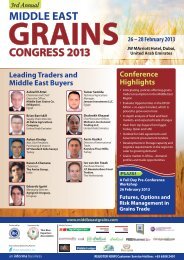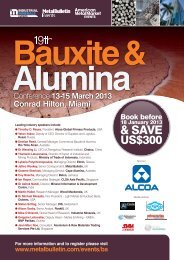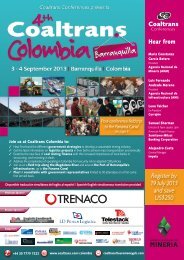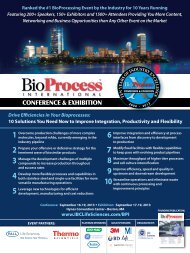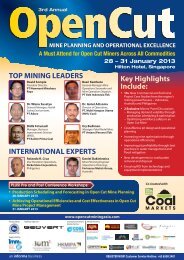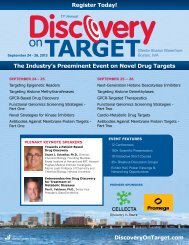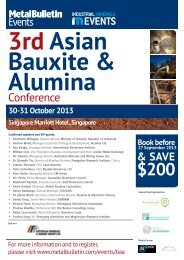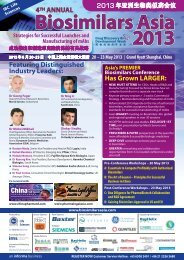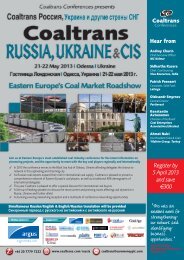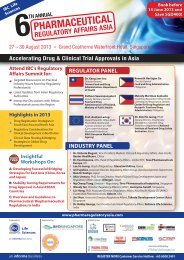Cell Line Development & Engineering
Cell Line Development & Engineering
Cell Line Development & Engineering
Create successful ePaper yourself
Turn your PDF publications into a flip-book with our unique Google optimized e-Paper software.
IBC’s 9th Annual<br />
<strong>Cell</strong> <strong>Line</strong> <strong>Development</strong><br />
& <strong>Engineering</strong><br />
Hear Case Studies from<br />
Genentech, Lonza,<br />
MedImmune, Abbott, Pfizer,<br />
Boehringer Ingleheim,<br />
Eli Lilly, BMS, Novartis<br />
& more...<br />
Improve All Aspects of Bioproduct <strong>Development</strong> by<br />
Leveraging Cutting-Edge Technical and Process Innovation<br />
May 20-22, 2013 • Hyatt Regency La Jolla at Aventine • La Jolla, CA<br />
Gain Perspectives from Exclusive Case Studies<br />
and Unpublished Data to Help You –<br />
➜ Develop a Custom <strong>Cell</strong> <strong>Line</strong> Toolbox with Diverse<br />
Product Quality Attributes<br />
➜ Utilize Molecular Assessment Programs to Balance<br />
Upstream Work with Downstream Payoffs<br />
➜ Apply Next Generation Sequencing Technologies in<br />
Biomanufacturing<br />
➜ Integrate Multiple Omics Data Sets to Understand<br />
Growth Rate Regulation in CHO<br />
➜ Overcome <strong>Cell</strong> <strong>Line</strong> and Process <strong>Development</strong><br />
Challenges for Biosimilars<br />
➜ Incorporate High Throughput Imaging to Increase<br />
the Assurance of Clonality<br />
Gold Sponsor: Silver Sponsor:<br />
Bronze Sponsors:<br />
Premier Publication:<br />
Keynote Presentations<br />
Coordinated Oscillations in Cortical<br />
Actin and Ca(2+) Correlate with<br />
Cycles of Vesicle Secretion<br />
Roy Wollman, Ph.D.<br />
Assistant Professor,<br />
Chemistry and Biochemistry<br />
University of California San Diego<br />
Higher-Faster-Further: Why It Makes<br />
Sense to Invest in Innovation to Achieve<br />
Disruptive Improvements<br />
Torsten W. Schulz, Ph.D.<br />
Director, <strong>Cell</strong> Culture,<br />
Boehringer Ingelheim Fremont, Inc.<br />
Featured Presentations<br />
Stable Depletion of miR-7 Expression<br />
for Improved Performance of<br />
a CHO Batch-Fed Culture<br />
Niall Baron, Ph.D.<br />
Senior Research Scientist, National<br />
Institute for <strong>Cell</strong>ular Biotechnology,<br />
Dublin City University, Ireland<br />
Technology Toolbox for <strong>Cell</strong> <strong>Line</strong><br />
<strong>Development</strong> – Towards High Speed,<br />
Yield and Clonal Stability<br />
Thomas Jostock, Ph.D.<br />
Novartis Leading Scientist<br />
Novartis Pharma AG, Switzerland<br />
www.IBCLifeSciences.com/<strong>Cell</strong><strong>Line</strong>
Join Industry Leaders at IBC’s 9th Annual<br />
<strong>Cell</strong> <strong>Line</strong> <strong>Development</strong> & <strong>Engineering</strong><br />
May 20-22, 2013<br />
Hyatt Regency La Jolla at Aventine<br />
La Jolla, CA<br />
IBC’s <strong>Cell</strong> <strong>Line</strong> <strong>Development</strong> & <strong>Engineering</strong> conference is driven by the novel<br />
approaches and emerging tools that are designed to save you time and money<br />
during the process of selecting, developing and engineering your cell lines.<br />
In 3 information packed days, you hear experiences, successes and lessons<br />
learned from companies utilizing the rapidly expanding technology toolbox to<br />
dramatically improve the speed of cell line development, minimize risk, and<br />
increase process and product quality.<br />
Industry leaders and world-renowned academics share exclusive case studies and<br />
unpublished data, providing you with the information required to overcome your<br />
toughest challenges and help your company achieve:<br />
• The promise of ‘omics technologies in process development<br />
• High production stability with targeted integration<br />
• Improved cell density and prolonged viability with stable depletion of miR-7<br />
• Lead candidates with optimal stability, productivity, safety and delivery<br />
characteristics from early developability assessments<br />
• Improved collaboration at the interface of development and discovery<br />
• Better understanding of gene expression regulation with next<br />
generation sequencing<br />
• Big timeline reductions through engineering of host cell line and<br />
expression vector<br />
• In process control of glycosylation during high yield production<br />
Gain Recognition from Your<br />
Peers and Present a Poster<br />
Sponsored by:<br />
IBC’s <strong>Cell</strong> <strong>Line</strong> 2013 SAFC Young Investigator<br />
Poster Awards are dedicated to recognizing<br />
the recent achievements of graduate students,<br />
post docs and research scientists that are<br />
driving this field forward.<br />
Posters are reviewed and judged by the Scientific Advisory Committee<br />
for most novel application by a graduate student, post doc and research<br />
scientist. The three winning posters will be announced during the conference<br />
on Wednesday, May 22nd at 8am.<br />
The deadline to submit an abstract for inclusion in the conference materials is<br />
Monday, April 29, 2013 (Abstract and full payment of conference and poster<br />
fees must be received by this date.) After that date, posters are on a space<br />
available basis.<br />
To submit your poster and for additional details on the poster sizes and<br />
regulations, please visit www.IBCLifeSciences.com/<strong>Cell</strong><strong>Line</strong>. Only one poster<br />
presentation will be allowed per registered attendee/author.<br />
Gold Sponsor<br />
Pall’s leading edge separation, purification, cell culture, analytical<br />
technologies and services play an essential role in the Life Sciences<br />
industry. Pall single-use and traditional filtration, chromatography,<br />
fluid handling, sampling, monitoring and quality assurance<br />
products and engineered systems, together with technical services<br />
in validation, assays and process optimization are applicable to all<br />
phases and scales of therapeutic, vaccine, and diagnostic product<br />
research, development and manufacturing.<br />
Silver Sponsor<br />
Life Technologies is a global leader in bioprocessing, supporting<br />
biologics based therapeutics and vaccines from molecule to market<br />
with leading brands such as Gibco ® cell culture products and cell<br />
therapy systems; POROS ® chromatography; and SEQ pharmaceutical<br />
analytics. Our portfolio of bioproduction services includes cell line<br />
development and media optimization.<br />
Bronze Sponsors<br />
Poster Award Sponsor<br />
Technology Workshop Sponsors<br />
Badge and Lanyard Sponsor<br />
Conference Supporter<br />
Exhibitors (as of January 11, 2013)<br />
ATR, Inc<br />
Molecular Devices<br />
Life Technologies<br />
Pall Life Sciences<br />
MaxCyte<br />
TAP Biosystems<br />
Drive Your Global Sales and Marketing<br />
IBC’s Bioprocessing Series events provide a number of<br />
sponsorship and exhibiting opportunities you can choose from<br />
to meet your goals before, during and after the event. IBC’s<br />
sponsorships ensure you the proper balance between attendees<br />
and exhibitors so you can spend more time developing<br />
your deals and less time searching for possible partners.<br />
Sponsorship/Exhibiting opportunities include Technology<br />
Workshops (including a thirty minute speaking slot); Session<br />
Sponsorships; Reception, Luncheon and Break Sponsorships;<br />
Delegate Focus Groups; Imprinted Giveaways; and much more.<br />
To learn more about sponsoring or exhibiting, please contact:<br />
A-L: Jennifer Thebodo at 508-614-1672<br />
or jthebodo@ibcusa.com<br />
M-Z: Ellen Moorehead at (508) 614-1406<br />
or emoorehead@ibcusa.com<br />
2 Register Early for Best Savings • www.IBCLifeSciences.com/<strong>Cell</strong><strong>Line</strong> • 800-390-4078
Monday, May 20, 2013<br />
7:00 Registration and Coffee<br />
8:00 Chairwoman’s Opening Remarks – The Legal, Regulatory<br />
and Technical Landscape<br />
Laurie Donahue-Hjelle, Ph.D., Director, New Product <strong>Development</strong>,<br />
Life Technologies<br />
Keynote Addresses<br />
8:15 CASE STUDY Coordinated Oscillations in Cortical<br />
Actin and Ca(2+) Correlate with Cycles of<br />
Vesicle Secretion<br />
The actin cortex both facilitates and hinders the exocytosis<br />
of secretory granules. How cells consolidate these two<br />
opposing roles was not well understood. Here we show using multi-color<br />
fluorescent microscopy that antigen activation of mast cells induces<br />
oscillations in Ca(2+) and PtdIns(4,5)P(2) lipid levels that in turn drive<br />
cyclic recruitment of N-WASP and cortical actin level oscillations. These<br />
oscillations increase secretion efficiency, explaining how the actin cortex can<br />
function as a carrier as well as barrier for vesicle secretion.<br />
Roy Wollman, Ph.D., Assistant Professor, Chemistry and Biochemistry,<br />
University of California San Diego<br />
8:45 CASE STUDY • UNPUBLISHED DATA Higher-Faster-Further:<br />
Why It Makes Sense to Invest in Innovation to<br />
Achieve Disruptive Improvements – A Case<br />
Study About 2nd Generation Media <strong>Development</strong><br />
The pressure to reduce COGS will likely increase. The<br />
biopharmaceutical industry needs to pro-actively address this development<br />
by having the appropriate strategies to increase productivity significantly. This<br />
requires a dedicated commitment to innovative ideas that include state of the art<br />
scientific approaches for significant improvements. The case study correlates the<br />
investment in innovation with the outcome of a multi-year innovation project.<br />
Torsten W. Schulz, Ph.D., Director, <strong>Cell</strong> Culture,<br />
Boehringer Ingelheim Fremont, Inc.<br />
9:15 Speed Networking Refreshment Break and Poster/Exhibit Viewing<br />
Working Closer with Drug Discovery and Research to<br />
Improve <strong>Cell</strong> <strong>Line</strong> <strong>Development</strong> and Minimize Risk<br />
10:15 UNPUBLISHED DATA <strong>Cell</strong> <strong>Line</strong> <strong>Development</strong> for Novel<br />
Molecules - Perspectives from the Interface of<br />
Discovery and <strong>Development</strong><br />
Abstract not available at time of print. Please visit<br />
www.IBCLifeSciences.com/<strong>Cell</strong><strong>Line</strong> for updates.<br />
Stephanie E. Rieder, Senior Scientist III, Global Biologics, AbbVie<br />
10:45 CASE STUDY • UNPUBLISHED DATA Molecular Assessment (MA)<br />
Programs – Balancing Upstream Work with<br />
Downstream Payoffs<br />
Producing recombinant proteins and antibodies with manufacturability<br />
problems often presents a significant barrier to the clinical and commercial<br />
feasibility of a project. Methods to identify problematic molecules early in the<br />
drug development process can serve a valuable purpose by either eliminating<br />
these molecules from consideration or by providing advance notice so that<br />
proactive steps can be taken to minimize timeline delays. This presentation<br />
describes selected Molecule Assessment (MA) considerations implemented at<br />
Genentech, highlighting examples identified at different stages in the process.<br />
Laura Simmons, Senior Scientist, Early Stage <strong>Cell</strong> Culture, Genentech, Inc.<br />
“Quite worthwhile!<br />
Informative, encompassing, broad and yet relevant topics.<br />
Great venue for discussion and interaction.”<br />
- Lynn Davis, Ph.D., Senior Research Biologist, Bend Research Inc.<br />
11:15 CASE STUDY • UNPUBLISHED DATA Surviving the Valley of Death - Pre-<br />
<strong>Cell</strong> <strong>Line</strong> Generation Strategies to Reduce Attrition in Later<br />
Stages of Biopharmaceutical <strong>Development</strong><br />
The majority of new biopharmaceutical candidates fail during preclinical<br />
and clinical development in what some describe as the ‘valley of death’<br />
of drug development. The challenge faced by drug developers is to find<br />
new ways of screening out early on in development those compounds<br />
that have a lower probability of success. Developability strategies applied<br />
before the development of production cell lines do address aspects<br />
of manufacturability, safety and delivery that could impact negatively<br />
later stages of development. They constitute an alternative approach to<br />
QbD, targeting risks present in the product itself. It is expected that the<br />
incorporation of this type of assessment early on in biopharmaceutical<br />
development will help reduce cost, attrition and development timelines.<br />
Jesús Zurdo, Ph.D., Head of Innovation, Biopharmaceutical <strong>Development</strong>,<br />
Lonza, United Kingdom<br />
11:45 Technology Workshop<br />
Simple Methods to Make Your <strong>Cell</strong> <strong>Line</strong> Shine<br />
Tremendous efforts have gone into shortening stable cell line development.<br />
Once those months are invested, there is a desire for the selected clone to<br />
shine very quickly with regards to titer and sustainable product quality. This<br />
presentation will explore simple methods to attain next level titers in CHO<br />
fed-batch processes once you’ve selected your expression clone.<br />
Cynthia Hoy, Ph.D, Process Science Fellow, PD Direct® Services –<br />
Life Technologies<br />
12:15 Luncheon and Poster/Exhibit Viewing<br />
1:15 Chairman’s Remarks - Are ‘omics Approaches Anything<br />
other than Intellectual (Academic) Interest - Does Data<br />
Obtained have Track Record of Translating to Making a<br />
Difference in Processes<br />
Kevin McCarthy, Ph.D., Group Leader for <strong>Cell</strong> Sciences, EMD Serono Inc.<br />
Application, Integration and Characterization of ‘Omics<br />
in <strong>Cell</strong> <strong>Line</strong> <strong>Development</strong><br />
1:30 UNPUBLISHED DATA Application of Genomic Technologies<br />
to <strong>Cell</strong> <strong>Line</strong> <strong>Development</strong><br />
The recent publication of a draft CHO genome has set the stage for detailed<br />
molecular and genetic understanding of growth and protein production in<br />
mammalian cells, which will enable - the recognition of patterns of gene expression<br />
that correlate to process suitability and allow knowledge based selection of clones;<br />
development of pathway engineering strategies to improve the host cell line;<br />
process, media and feed development by optimisation of cellular responses.<br />
Nicole Borth, Ph.D., Professor, Department of Biotechnology,<br />
University of Bodenkultur, Austria<br />
2:00 UNPUBLISHED DATA <strong>Development</strong> of a CHO<br />
Mass Spectrometry Database<br />
New sequence information on Chinese hamster ovary cells offers the potential<br />
to improve the interpretation of CHO proteomic results, and thus a greater<br />
understanding of the underlying biological mechanisms of CHO cells in<br />
biopharmaceutical processes. In this presentation, we demonstrate the use<br />
of CHO-specific sequence information to improve the identification of CHO<br />
proteins using mass spectrometry-based proteomic analysis.<br />
Paula Meleady, Ph.D., Senior Research Scientist, Program Leader,<br />
Proteomics Core Facility, National Institute for <strong>Cell</strong>ular Biotechnology,<br />
Dublin City University, Ireland<br />
2:30 UNPUBLISHED DATA <strong>Engineering</strong> the CHO Genome for Improved<br />
Transgene Integration and Expression<br />
Epigenetic regulatory DNA elements prevent silencing and increase transgene<br />
integration and transcription for high and stable therapeutic production.<br />
We have sequenced the genome and transcriptome of a CHO cell line and of<br />
derived producer cell clones, yielding information on the integration locus,<br />
transgene integrity and copy number. Information on possible mechanisms<br />
allowing vector genomic integration was also obtained, providing approaches<br />
to further optimize transgene integration and expression.<br />
Nicolas Mermod, Ph.D., Professor, Director, Institute of Biotechnology,<br />
University of Lausanne, Switzerland<br />
For up-to-date program information and new abstracts, visit: www.IBCLifeSciences.com/<strong>Cell</strong><strong>Line</strong> 3
Monday, May 20, 2013 (continued)<br />
3:00 CASE STUDY • UNPUBLISHED DATA Proteomic Analysis of Chinese<br />
Hamster Ovary (CHO) <strong>Cell</strong>s<br />
To complement the recent genomic sequencing of Chinese hamster ovary<br />
(CHO) cells, proteomic analysis was performed on CHO cells including the<br />
cellular proteome, secretome, and glycoproteome using mass spectrometry<br />
and multiple strategies. A total of 6164 grouped proteins were identified. This<br />
first large-scale proteomic analysis enhances the knowledge base about CHO<br />
capabilities for recombinant expression and cell line engineering.<br />
Deniz Baycin Hizal, Ph.D., Chemical and Biomolecular <strong>Engineering</strong>,<br />
Johns Hopkins University<br />
3:30 Networking Refreshment Break and Poster/Exhibit Viewing<br />
Proliferation and Integration of Data Sets<br />
4:00 Integrated miRNA, mRNA and Protein Expression Analysis<br />
Reveals the Role of Post-Transcriptional Regulation in<br />
Controlling CHO <strong>Cell</strong> Growth Rate<br />
To investigate the role of microRNA (miRNA) in the regulation of Chinese<br />
hamster ovary (CHO) cell growth, qPCR, microarray and quantitative LC-MS/<br />
MS analysis were utilised for simultaneous expression profiling of miRNA, mRNA<br />
and protein. In this presentation, the biological processes found to be correlated<br />
with CHO cell growth rate is discussed and the analysis of multiple datasets to<br />
identify potential miRNA-mediated regulation demonstrated.<br />
Colin Clarke, Ph.D., Postdoc, National Institute for <strong>Cell</strong>ular Biotechnology,<br />
Dublin City University, Ireland<br />
4:30 UNPUBLISHED DATA Using Metabolite Profiling Data to Make a<br />
Difference to CHO <strong>Cell</strong> Bioprocesses<br />
Metabolite profiling offers an ‘omics approach that enables a very<br />
immediate read-out of the status of CHO cells in culture. From an<br />
integrated analysis of profile changes, interpretations can be attained of<br />
metabolic phenotype associated with growth and/or recombinant protein<br />
production. This presentation illustrates our molecular understanding of<br />
relationships between feeding, cellular metabolism and desirable phenotype<br />
in CHO cells.<br />
Alan Dickson, Ph.D., Director, Centre of Excellence in Biopharmaceuticals,<br />
Professor of Biotechnology, University of Manchester, United Kingdom<br />
5:00 UNPUBLISHED DATA Genome-Scale Analysis of Chinese Hamster<br />
Ovarian <strong>Cell</strong> <strong>Line</strong>s<br />
Over the past 15 years, microbe-based engineering has advanced through<br />
three major innovations: 1) genome sequencing, 2) genome-scale metabolic<br />
models, and 3) tools for genome editing. These have allowed engineers to<br />
identify cellular parts, simulate product synthesis, and manipulate host<br />
genomes to enhance production. Similar advances are now upon us in the<br />
engineering of CHO cell lines for bioprocessing.<br />
Bernhard Palsson, Ph.D., Principal Investigator, Galletti Professor of<br />
Bioengineering, Adjunct Professor Medicine, University of California, San Diego<br />
5:30 Cocktail Reception in Poster/Exhibit Hall<br />
Tuesday, May 21, 2013<br />
7:30 Coffee<br />
8:00 Chairman’s Opening Remarks<br />
Rodney Combs, M.S., Associate Research Fellow, Bioprocess R&D, Culture<br />
Process <strong>Development</strong>, World Wide Pharmaceutical Sciences, Pfizer Inc.<br />
Approaches to Improve Process and Product Quality<br />
8:15 CASE STUDY Clonality – Challenges, Approaches and<br />
Lessons Learned<br />
Abstract not available at time of print. Please visit<br />
www.IBCLifeSciences.com/<strong>Cell</strong><strong>Line</strong> for updates.<br />
Pamela Hawley-Nelson, Ph.D., Associate Director, Process <strong>Cell</strong> Culture,<br />
MedImmune<br />
8:45 Use of QPCR and DNA Sequencing Tools to Ensure<br />
Product Quality and Safety<br />
Quantitative PCR (Q-PCR) and DNA sequencing are tools that enable rapid,<br />
sensitive and precise quantitation, detection and identification of critical<br />
cellular and process impurities in cell culture manufacturing and product<br />
purification. Additionally, these tools can be utilized in development and<br />
characterization of production cell lines and in routine monitoring of cell line<br />
stability. In this presentation, the applications of these technologies and present<br />
data demonstrating the performance of assays for impurity assessment, cell line<br />
characterization, contaminant detection and identification are reviewed.<br />
Michael T. Brewer, Director, Head of Pharma Analytics, Life Technologies<br />
9:15 UNPUBLISHED DATA High-Throughput Product Quality Assays for<br />
<strong>Cell</strong> <strong>Line</strong> and Process <strong>Development</strong><br />
Here we present high-throughput (HTP) analytical assays to facilitate rapid<br />
product quality using 96-well plate formats. These HTP product quality assays<br />
include HTP protein quantitation followed by HTP protein purification and<br />
product quality analyses. With these HTP analytical product quality assays we can<br />
assess product quality in the early stage of clone screening, as well as expedite the<br />
cell line and process development.<br />
Shashi Prajapati, Ph.D., Senior Scientist, <strong>Cell</strong> Culture <strong>Development</strong>,<br />
High Throughput Analytical Group. Biogen Idec<br />
9:45 Networking Refreshment Break and Poster/Exhibit Viewing<br />
10:15 CASE STUDY • UNPUBLISHED DATA Impact of Media Components and<br />
Process Parameters on Product Color<br />
Health Authorities expect that companies monitor and control the color<br />
of liquid formulations of monoclonal antibodies. <strong>Cell</strong> culture conditions<br />
and media components were investigated and shown to influence color.<br />
Mechanisms that could explain these effects are discussed. Some process<br />
changes that reduced color also decreased titer, and strategies for reducing<br />
color which avoid productivity impact are discussed.<br />
Natarajan Vijayasankaran, Ph.D., Senior Engineer, Late Stage <strong>Cell</strong> Culture,<br />
Genentech, Inc.<br />
10:45 CASE STUDY • UNPUBLISHED DATA Viability and Productivity<br />
Improvement on Mammalian Fed Batch Culture<br />
Abstract not available at time of print. Please visit<br />
www.IBCLifeSciences.com/<strong>Cell</strong><strong>Line</strong> for updates.<br />
Wenge Wang, Ph.D., Senior Principal Scientist, Bioprocess Research and<br />
<strong>Development</strong>, Pfizer Inc.<br />
11:15 Technology Workshop<br />
A New Bench Scale Single-Use<br />
Bioreactor System<br />
<strong>Development</strong> of a new bench scale “rocker style” single use bioreactor<br />
will be described, with discussion of physical parameters for design space<br />
definition and performance measurement; with comparison to industry<br />
standard systems. Presentation will conclude with results from CHO<br />
batch culture trials for design validation, showing significant increases in<br />
achievable cell densities and cell productivity.<br />
Charles G. Golightly, Global Product Manager, Pall Life Sciences<br />
11:45 Luncheon and Poster/Exhibit Viewing<br />
Send a group of 3 and the 4th goes FREE!<br />
It’s a fact – attendees walk away with the most value when they<br />
experience it with a peer – there is just too much information available<br />
for one person to capture it all. As a result, we are pleased to offer a<br />
4th free registration when you register 3 people at the standard rate.<br />
For more information call our group sales advocate at 646-895-7445.<br />
4 Register Early for Best Savings • www.IBCLifeSciences.com/<strong>Cell</strong><strong>Line</strong> • 800-390-4078
Tuesday, May 21, 2013 (continued)<br />
12:55 Chairman’s Remarks<br />
Andy Lin, Ph.D., Process Research & <strong>Development</strong>, Genentech, Inc.<br />
Approaches to Improve <strong>Cell</strong> <strong>Line</strong> <strong>Development</strong> Efficiencies,<br />
Resources and Timelines – What is the Impact<br />
1:00 CASE STUDY • UNPUBLISHED DATA Strategies to Fast/Lean POC and<br />
Risk Mitigation<br />
Fast/lean to PoC is highly desired for drug development. However, fast/lean<br />
cell line generation could potentially result in the identification of clonal cell<br />
lines that are only suitable for early-phase development and result in the<br />
need to change cell lines for commercial development, which can pose a<br />
significant challenge in demonstrating consistency of processes/products. In<br />
this presentation, we share recloning case studies as a potential mitigation<br />
strategy to the risks associated with fast/lean to PoC approaches.<br />
Luhong He, Ph.D., Senior Research Scientist, Eli Lilly and Company<br />
1:30 Streamlining Antibody <strong>Development</strong> Using Large Scale,<br />
CHO Transient Gene Expression (TGE) Followed by Rapid<br />
Production of CHO Stable Pools<br />
Antibody production for early stage antibody development activities is<br />
commonly conducted using transiently transfected HEK cells to produce<br />
adequate quantities of antibody for characterization, while later stage<br />
screening and biomanufacturing rely on CHO-based stable cell lines.<br />
Migration from HEK to CHO cell backgrounds can lead to manufacturing<br />
challenges and changes in post translational modifications that can alter<br />
the antibody’s therapeutic potential. The time line of antibody development<br />
can be greatly streamlined using large scale transient gene expression<br />
(TGE) directly within CHO cells. CHOS cells can be transfected with >95%<br />
transfection efficiency and cell viability using MaxCyte flow electroporation.<br />
MaxCyte transiently transfected CHO cells produce antibody titers > 400<br />
mg/L, enabling greater than 1 gram of protein from 1g/L.<br />
James Brady, Ph.D., MBA, Director of Technical Applications, MaxCyte<br />
2:00 CASE STUDY • UNPUBLISHED DATA Accelerating <strong>Cell</strong> <strong>Line</strong> Screening and<br />
Selection Using a Multiplexed 24 Well Microbioreactor and<br />
Streamlined Purification<br />
Abstract not available at time of print. Please visit<br />
www.IBCLifeSciences.com/<strong>Cell</strong><strong>Line</strong> for updates.<br />
Jessica Wuu, Ph.D., M.S., Senior Scientist, Process Sciences,<br />
Abbott Laboratories<br />
2:30 CASE STUDY • UNPUBLISHED DATA Faster Upstream <strong>Development</strong> for<br />
Therapeutic Proteins: The Contribution of the GS-KO Host<br />
<strong>Cell</strong> <strong>Line</strong><br />
The GS Gene Expression System is widely used for cGMP manufacturing<br />
of therapeutic proteins using mammalian cells. Currently, thirteen licensed<br />
products are manufactured using the GS System. Although the system is<br />
well established, Lonza is continually improving the GS System. Recent<br />
improvements have focussed on a number of areas including reducing<br />
the time for cell line development. The latter was achieved partly through<br />
introduction of a GS-knockout version, CHOK1SV GS-KO, of its standard<br />
CHO host. This talk describes some of work to develop and characterise<br />
the new host cell line, along with comparative performance data from 10 L<br />
bioreactor cultures, and the benefits from switching to the new host.<br />
Andrew Racher, Ph.D., Head of Process <strong>Development</strong> Sciences,<br />
Lonza Biologics plc, United Kingdom<br />
3:00 Networking Refreshment Break and Poster/Exhibit Viewing<br />
Premier Publication:<br />
Media Partners:<br />
<br />
Tribute to the Legacy of Marty Sinacore –<br />
Reflections and State-of-the-Art Advances<br />
3:30 Chairman’s Remarks<br />
Sadettin S. Ozturk, Ph.D., Senior Director, Head of Process <strong>Development</strong>,<br />
MassBiologics<br />
3:45 A Tribute to Marty Sinacore<br />
Marty Sinacore has been one of the contributors of<br />
developing today’s technology used for mammalian cell<br />
based production. Besides being a great scientist Marty has<br />
been the mentor of countless young scientists that now are<br />
part of the backbone of our community. In this<br />
presentation, Tim and Thomas highlight some of<br />
Marty’s work and how it influenced the way we do cell<br />
based manufacturing today.<br />
Tim Charlebois, Ph.D., Vice President,<br />
Technology & Innovation Strategy, Pfizer Inc.<br />
Thomas Ryll, Ph.D., Senior Director, <strong>Cell</strong> Culture <strong>Development</strong>, Biogen Idec<br />
4:30 UNPUBLISHED DATA <strong>Development</strong> of a Custom <strong>Cell</strong> <strong>Line</strong> Toolbox<br />
with Diverse Product Quality Attributes<br />
Although the simplicity of having a single, well characterized host upon<br />
which to initiate cell line engineering has many advantages, a one size<br />
fits all approach does have its drawbacks. The range of product quality<br />
attributes achievable will be limited by the intrinsic phenotype of said host<br />
and may not overlap with the optimum profile for a given therapeutic. With<br />
the increased sophistication of engineering tools enabling precise genome<br />
editing or mRNA depletion, it’s now relatively straight forward to develop<br />
modified hosts with tailored made phenotypes. The end result being the cell<br />
line engineer can develop a “toolbox” of varied hosts that can be employed<br />
to insure that critical quality attributes or biosimilarity is achievable.<br />
Scott Estes, Ph.D., Director, <strong>Cell</strong> Culture <strong>Development</strong>, Biogen Idec<br />
5:00 The Impact of ‘Omics Technologies on Process<br />
<strong>Development</strong> – The Promise and the Reality<br />
It was just over 10 years ago that the use of ‘omics technologies started<br />
to make their way into bioprocess development. For many early adopters<br />
of the technology, the promise was a better fundamental understanding<br />
of cell biology that would lead to engineered cell lines that would be<br />
optimized for production of secreted biotherapeutics. That isn’t what<br />
happened, however.<br />
Mark Melville, Ph.D., Senior Director, Bioprocess <strong>Development</strong>,<br />
Epirus Biopharmaceuticals<br />
5:30 CASE STUDY • UNPUBLISHED DATA Preservation of a Balanced <strong>Cell</strong><br />
Culture Environment for Fed-Batch Processes<br />
This presentation demonstrates with examples the effect of cell culture<br />
imbalance on cell growth and productivity, as well as specific solutions to<br />
remedy these issues. A simple solution to revive the drop in cell viability<br />
observed during the late stage of cell culture is also discussed. Finally, a<br />
systematic approach of medium feeding to achieve high cell density, high<br />
viability, and high titer process is also described.<br />
Yen-Tung Luan, M.S., Associate Research Fellow, Bioprocess R&D, Pfizer Inc.<br />
“By narrowly targeting the technologies used<br />
at the border of R&D of biotherapeutics, this event provides<br />
an intensive 3-day review of current, valuable information<br />
for this highly specialized group.”<br />
- Pam Hawley-Nelson, Ph.D., Associate Director,<br />
Process <strong>Cell</strong> Culture, MedImmune<br />
For up-to-date program information and new abstracts, visit: www.IBCLifeSciences.com/<strong>Cell</strong><strong>Line</strong> 5
6:00 Dinner Symposium (Special registration required) Tuesday, May 21, 2013 (continued)<br />
Please join us for this highly interactive 3 hour evening exchange in a roundtable format, which encourages participants to share their experiences<br />
and concerns amongst several discussion topics that include:<br />
What Is the State-of-the-Art in Expression<br />
Are We Hitting Our Limits<br />
Moderators:<br />
Laurie Donahue-Hjelle, Ph.D., Director, New Product <strong>Development</strong>,<br />
Life Technologies<br />
Andrew Racher, Ph.D., Head of Process <strong>Development</strong> Sciences,<br />
Lonza Biologics plc, United Kingdom<br />
Are There Any Emerging Platforms that Could Supersede CHO<br />
Moderators:<br />
Rodney Combs, M.S., Associate Research Fellow, Bioprocess R&D, Culture<br />
Process <strong>Development</strong>, World Wide Pharmaceutical Sciences, Pfizer Inc.<br />
Jesús Zurdo, Ph.D., Head of Innovation, Biopharmaceutical <strong>Development</strong>,<br />
Lonza, United Kingdom<br />
How Do We Leverage the CHO Genome Info<br />
Moderators:<br />
Kelvin Lee, Ph.D., Gore Professor of Chemical <strong>Engineering</strong>, Delaware<br />
Biotechnology Institute Faculty Fellow, University of Delaware<br />
Alan Dickson, Ph.D., Director, Centre of Excellence in Biopharmaceuticals,<br />
Professor of Biotechnology, University of Manchester, United Kingdom<br />
Viral Risk Mitigation Strategies<br />
Moderators:<br />
Andy Lin, Ph.D., Process Research & <strong>Development</strong>, Genentech, Inc.<br />
Pamela Hawley-Nelson, Ph.D., Associate Director, Process <strong>Cell</strong> Culture,<br />
MedImmune Inc<br />
Phase-Appropriate, Regulatory Expectations Regarding <strong>Cell</strong><br />
<strong>Line</strong> and <strong>Cell</strong> Culture Processes (Bulk Culture, Non-GMP for<br />
First Human Dose (FHD))<br />
Moderators:<br />
Luhong He, Ph.D., Senior Research Scientist, Eli Lilly and Company<br />
Stephanie E. Rieder, Senior Scientist III, Global Biologics, AbbVie<br />
Agenda:<br />
6:00-7:00 pm Discussion Groups<br />
7:00-8:00 pm Dinner<br />
8:00-9:00 pm Dessert and summaries from each discussion<br />
Additional registration fee required – see page 7 for details<br />
Wednesday, May 22, 2013<br />
7:30 Coffee<br />
8:00 Chairman’s Remarks and Announcement of Poster Winners<br />
Kevin J. Kayser, Ph.D., Director, <strong>Cell</strong> Sciences and <strong>Development</strong>, SAFC<br />
Applying Disruptive Technologies and Their Impact on<br />
<strong>Cell</strong> <strong>Line</strong> <strong>Development</strong> and <strong>Engineering</strong><br />
8:15 <strong>Cell</strong> <strong>Line</strong> <strong>Engineering</strong> Applications of Zinc Finger<br />
Nuclease(ZFN) Technology to Reduce the Risk Profile in<br />
Therapeutic Manufacturing Processes<br />
Zinc Finger Nucleases (ZFNs) are a class of engineered DNA-binding proteins that<br />
facilitate targeted editing of the genome by creating double-strand breaks in DNA at<br />
user-specified locations. We have conducted significant research and development<br />
work to deploy ZFN technology across biopharmaceutical applications. SAFC has<br />
created several new commercial available Chinese Hamster Ovary (CHO) cell lines<br />
with modifications in specific genes of interest. Example cell lines include CHO<br />
GS-/- and CHO dhfr-/- deletions. This talk begins with an overview of the ZFN<br />
technology and specific CHO cell line engineering applications but focuses on<br />
current research to create CHO cell lines with reduced risk profiles.<br />
Kevin J. Kayser, Ph.D., Director, <strong>Cell</strong> Sciences and <strong>Development</strong>, SAFC<br />
8:45 UNPUBLISHED DATA Next Generation Sequencing Technologies and<br />
Applications in Biomanufacturing<br />
The rapid pace of development of technologies for high throughput analysis of<br />
nucleic acid sequence information is beginning to have an important impact<br />
on cell line development. In this presentation, we discuss an overview of the<br />
variety of next generation sequencing technologies that are available and being<br />
employed to study mammalian cell lines and discuss impact of the application of<br />
these technologies to problems relevant to the biomanufacturing community.<br />
Kelvin H. Lee, Ph.D., Gore Professor of Chemical <strong>Engineering</strong>, Director of the<br />
Delaware Biotechnology Institute, University of Delaware<br />
9:15 CASE STUDY • UNPUBLISHED DATA Generic Characterization of Stable<br />
CHO <strong>Line</strong>s by Next Generation Sequencing<br />
One of the major challenges in biologic drug development is product<br />
heterogeneity as a result of contamination, mutation or alternative splicing in<br />
transcription. Traditional methods such as cloning and Sanger sequencing, etc.<br />
are inefficient and even incompetent in detection of generic variants, especially<br />
in low amount. NGS, a powerful tool in decipher genetic information, was<br />
applied on the task and was demonstrated as a perfect fit in molecular<br />
characterization of biotherapeutics during drug development.<br />
Junjian Liu, Ph.D., Senior Scientist, Global Biologics, Abbott Laboratories<br />
9:45 Networking Refreshment Break<br />
Featured Presentations –<br />
Applying Novel <strong>Development</strong> & <strong>Engineering</strong> Strategies<br />
10:15 Stable Depletion of miR-7 Expression for Improved<br />
Performance of a CHO Batch-Fed Culture<br />
MicroRNAs are an important group of cellular genetic<br />
regulators that display several attractive traits as engineering<br />
targets. Their ability to influence the expression of multiple<br />
proteins and not require the cellular translational machinery means they<br />
might be useful in modifying entire cellular pathways without placing<br />
increased metabolic burden on producer cells. We report on the effect of<br />
constitutive depletion of miRNA-7 using decoy transcripts on the growth and<br />
productivity of CHO cells in fed-batch culture.<br />
Niall Baron, Ph.D., Senior Research Scientist, National Institute for <strong>Cell</strong>ular<br />
Biotechnology, Dublin City University, Ireland<br />
10:45 CASE STUDY • UNPUBLISHED DATA Technology Toolbox<br />
for <strong>Cell</strong> <strong>Line</strong> <strong>Development</strong> – Towards High<br />
Speed, Yield and Clonal Stability<br />
State of the art CHO platforms allow generation of high<br />
yielding production cell lines with short cycle times. Our<br />
strategy for further optimizing speed and yield of our CHO platform<br />
combines internal efforts with systematical screening and evaluation of<br />
external know-how. By integrating internal and external technologies we<br />
are aiming for further reducing cycle times and screening efforts of cell line<br />
development. Some novel vector technologies that we have evaluated to<br />
improve our platform towards high yielding fast processes, including a new<br />
selection marker and a targeted integration technology, will be presented.<br />
Thomas Jostock, Ph.D., Novartis Leading Scientist, Novartis Pharma AG,<br />
Switzerland<br />
11:15 Technology Workshop Opportunity<br />
For more information, please contact Jennifer Thebodo at 508-614-1672<br />
or jthebodo@ibcusa.com<br />
11:45 Lunch on Your Own<br />
New to the Field<br />
Consider Attending IBC’s Two-Day Intensive Training Course:<br />
<strong>Cell</strong> Culture and Fermentation Bioprocessing (separate registration required)<br />
East and West Coast Locations:<br />
May 14-15, 2013 in San Diego, CA •June 12-13, 2013 in Cambridge, MA<br />
Full course details available at www.IBCLifeSciences.com/Courses<br />
6 Register Early for Best Savings • www.IBCLifeSciences.com/<strong>Cell</strong><strong>Line</strong> • 800-390-4078
12:55 Chairman’s Remarks<br />
Lisa J. Graham, Ph.D., P.E., Senior Vice President, Bend Research Inc.<br />
Developing <strong>Cell</strong> <strong>Line</strong>s for Biosimilars<br />
1:00 Glycoexpress: A Toolbox of Human <strong>Cell</strong> <strong>Line</strong>s for the<br />
Production of Glycooptimized Biotherapeutics<br />
Glycosylation is the major post-translational modification of biotherapeutics<br />
that depends on the cell line used for production. By establishment of the<br />
GlycoExpress toolbox we have generated a set of glycoengineered human cell<br />
lines for the high yield production of fully human glycoproteins. Currently, five<br />
different cell lines are established which allow the production of glycoproteins<br />
with different glycosylation features.<br />
Steffen Goletz, Ph.D., Chief Executive Officer, Chief Scientific Officer,<br />
Glycotope GmbH, Germany<br />
1:30 UNPUBLISHED DATA Challenges in <strong>Cell</strong> <strong>Line</strong> and Process<br />
<strong>Development</strong> for NBEs and Biosimilars<br />
In developing NBEs and biobetters, speed, titer and an excellent product<br />
quality are all key elements, while for biosimilars, matching the originator<br />
product quality is the essential target. Here, we show how the use of our<br />
integrated BI-HEX platform which is based on well characterized cell lines<br />
and thorough understanding of USP and DSP processes is used to achieve<br />
fast and reliable development of high-titer cell lines and manufacturing<br />
processes, and how understanding of the process can be used to influence<br />
product quality attributes to successfully meet the target.<br />
Till Wenger, Ph.D., Associate Director, <strong>Cell</strong> Biology, <strong>Cell</strong> Culture II, Process<br />
Science, Boehringer Ingelheim, Germany<br />
2:00 2nd Generation Sequencing for <strong>Cell</strong> <strong>Line</strong> Characterization<br />
during Biosimilar <strong>Development</strong><br />
Biosimilar cell line development is a multi-step process, based on quality by<br />
design principles to generate a cell line producing a recombinant protein<br />
as similar to the originator’s protein as possible. Essential part of cell line<br />
development is genetic characterization. In addition to standard techniques,<br />
2nd generation sequencing technologies enable deeper look into the parts of<br />
genome and transcriptome interesting for cell line developers.<br />
Dominik Gaser, Ph.D., Senior Scientist, <strong>Cell</strong> & Molecular Biology,<br />
Sandoz Biopharmaceuticals, Slovenia<br />
2:30 Networking Refreshment Break<br />
Implementation of Analytical Tools and Strategies to<br />
Help Improve Clone Selection, Process Monitoring,<br />
Understanding and <strong>Development</strong><br />
3:00 UNPUBLISHED DATA High Throughput Imaging During <strong>Cell</strong> <strong>Line</strong><br />
<strong>Development</strong> to Increase the Assurance of Clonality<br />
We are developing a fluorescent high throughput automated imaging protocol that<br />
can provide direct evidence on whether the cell line originated from one cell during<br />
the cloning step. To accommodate the throughput of the cell line development<br />
workflow at Genentech, fluorescent cell staining and automated fluorescent cell<br />
counting are used to reduce the need to manually inspect brightfield images. Since<br />
image data is acquired to track clone growth for all clones during the single-cell<br />
cloning process, confluence data or other electronic data can be used to drive<br />
automated hit-picking from the 384-well plates thus increasing efficiency and<br />
reducing ergonomic stress. We discuss the challenges and solutions implemented<br />
during the development of this protocol.<br />
David Shaw, Ph.D., Scientist, Early Stage <strong>Cell</strong> Culture, Genentech, Inc.<br />
3:30 CASE STUDY • UNPUBLISHED DATA Data Integration Methodology<br />
that Leverages Coupled Bioreactor Analytics, Automated<br />
Sampling, and Applied Mathematics to Redefine Bioreactor<br />
Operation; Case Study Example Illustrating Impact on <strong>Cell</strong><br />
Culture Productivity<br />
Process analytics can provide key links between process operation and product<br />
quality by enabling better data to strategically meet dynamic nutrient requirements<br />
of cell cultures. Individual analytics tools can also be coupled using the right data<br />
integration and applied mathematics techniques to provide “real time” guidance<br />
for process design and operation. Examples are shown, including a case study<br />
linking dielectric spectroscopy frequency spectra with the onset of apoptosis,<br />
which can then be linked to changes in cell performance and productivity.<br />
Lisa J. Graham, Ph.D., P.E., Senior Vice President, Bend Research Inc.<br />
Wednesday, May 22, 2013 (continued)<br />
4:00 CASE STUDY • UNPUBLISHED DATA LC-MS/MS and Data Searching<br />
Strategies for Sequence Variance Detection<br />
Mass spectrometry provides a powerful tool for detecting low-abundance<br />
sequence variants within monoclonal antibodies. However, it is challenging<br />
to perform data analysis in a highly efficient and error-free manor. The use of<br />
currently available LC-MS instruments with high levels of sensitivity, precision<br />
and accuracy in combination with proteomic and statistical software allow<br />
for semi automation of data analysis for sequence variant analysis.<br />
Hangtian Song, Ph.D., Research Investigator I, Global Manufacturing and<br />
Supply, Bristol-Myers Squibb Co.<br />
4:30 Scale-Down Automated Purification and Protein Analytics<br />
to Facilitate <strong>Cell</strong> <strong>Line</strong> Screening/PQ Analysis<br />
Abstract not available at time of print. Please visit<br />
www.IBCLifeSciences.com/<strong>Cell</strong><strong>Line</strong> for updates.<br />
Ling Santora, Ph.D., Senior Scientist III, AbbVie<br />
5:00 Close of Conference<br />
3EASY WAYS<br />
TO REGISTER:<br />
Industry Fees By March 1, 2013<br />
By March 29,<br />
2013 By April 26, 2013<br />
Standard Rate<br />
After April 26, 2013<br />
Main Conference Plus<br />
Dinner Symposium (Tues PM)<br />
$2299 $2399 $2499 $2699<br />
Main Conference Only $1899 $1999 $2099 $2299<br />
Academic/Govt. Fees* By March 1, 2013<br />
By March 29,<br />
Standard Rate<br />
2013 By April 26, 2013 After April 26, 2013<br />
Main Conference Plus<br />
Dinner Symposium (Tues PM)<br />
$1599 $1699 $1799 $1999<br />
Main Conference Only $1199 $1299 $1399 $1599<br />
Present a Poster to Enhance Your Conference Experience<br />
All poster presenters must be registered conference attendees. The fee to present a poster in addition<br />
to your conference registration is:<br />
Vendors/Supplier*: $300 Pharma/Biotech: $100 Academic/Government: FREE<br />
* Vendor rate is for exhibiting/sponsoring companies and/or posters that upon review are of<br />
commercial/product focus<br />
Venue and Accommodations<br />
Hyatt Regency La Jolla<br />
3777 La Jolla Village Drive, San Diego, CA<br />
Priority Code: B13189PDFWDL<br />
CALL<br />
800.390.4078 or EMAIL<br />
+1.941.554.3500 @ reg@ibcusa.com<br />
WEB<br />
www.IBCLifeSciences.com/<strong>Cell</strong><strong>Line</strong><br />
Special Conference Rate<br />
$229 Per Night Plus Tax<br />
Tel: 858-552-1234 • Central Reservations: 402-592-6464 or 1-888-421-1442<br />
www.lajolla.hyatt.com<br />
Please call the hotel directly at the numbers above before April 19, 2013 to be included in IBC’s dedicated<br />
room block for this conference. Please identify yourself as a participant in IBC’s <strong>Cell</strong> <strong>Line</strong> <strong>Development</strong> and<br />
<strong>Engineering</strong> conference to receive the reduced room rate. Be sure to make you reservations as soon as possible<br />
as rooms tend to fill up very quickly and all reservations are subject to availability.<br />
Additional Registration Information<br />
For onsite registrations, please add $100.<br />
Program content and speakers subject to change. Conference badges are non-transferable and lost badges will<br />
not be replaced without payment of the full conference registration fee.<br />
Please note that payment is required in advance of the conference. Please make check(s) (in U.S. funds drawn<br />
on a U.S. bank) payable to IBC Life Sciences and attach to the registration form. Confirmation of your booking<br />
will be sent. Should you elect to pay by MasterCard, Visa or American Express, please send your credit card<br />
number, expiration date, name as it appears on card and signature along with the registration form.<br />
Registration Substitutions/Cancellations: If you need to make any changes or have any questions, please feel free to<br />
contact IBC’s customer service team via email at reg@ibcusa.com. Cancellations must be in writing and must be received<br />
by IBC prior to 10 business days before the start of the event. Upon receipt of a timely cancellation notice, IBC will issue<br />
a credit voucher for the full amount of your payment, which may be applied towards registration fees at any future IBC<br />
event held within 6 months after issuance (the “Expiration Date”). All credit vouchers shall automatically expire on the<br />
Expiration Date and shall thereupon become void. In lieu of issuance of a credit voucher, at your request, IBC will issue a<br />
refund less a $595 processing fee per registration. Registrants are advised that no credit vouchers or refunds will be issued<br />
for cancellations received 10 business days or less prior to start of the event, including cancellations due to weather or<br />
other causes beyond the Registrant’s control. IBC therefore recommends that registrants allow for unexpected delays in<br />
making travel plans. Substitutions are welcome at any time. If for any reason IBC decides to cancel this conference, IBC<br />
accepts no responsibility for covering airfare, hotel or other costs incurred by registrants, including attendees, sponsors,<br />
speakers and guests.<br />
SPECIAL NEEDS: If you have a disability or special dietary needs, please let us know in order that<br />
we may address your special needs for your attendance at this show. Please send your special<br />
needs via email to custserv@ibcusa.com. <br />
For up-to-date program information and new abstracts, visit: www.IBCLifeSciences.com/<strong>Cell</strong><strong>Line</strong> 7
IBC’s 9th Annual<br />
<strong>Cell</strong> <strong>Line</strong> <strong>Development</strong> & <strong>Engineering</strong><br />
May 20-22, 2013 • Hyatt Regency La Jolla at Aventine • La Jolla, CA<br />
Keynote Presentations<br />
Coordinated Oscillations in Cortical<br />
Actin and Ca(2+) Correlate with Cycles<br />
of Vesicle Secretion<br />
Roy Wollman, Ph.D.<br />
Assistant Professor,<br />
Chemistry and Biochemistry<br />
University of California San Diego<br />
Higher-Faster-Further: Why It Makes<br />
Sense to Invest in Innovation to Achieve<br />
Disruptive Improvements<br />
Torsten W. Schulz, Ph.D.<br />
Director, <strong>Cell</strong> Culture,<br />
Boehringer Ingelheim Fremont, Inc.<br />
Featured Presentations<br />
Stable Depletion of miR-7 Expression<br />
for Improved Performance of a CHO<br />
Batch-Fed Culture<br />
Niall Baron, Ph.D.<br />
Senior Research Scientist, National<br />
Institute for <strong>Cell</strong>ular Biotechnology,<br />
Dublin City University, Ireland<br />
Technology Toolbox for <strong>Cell</strong> <strong>Line</strong><br />
<strong>Development</strong> – Towards High Speed,<br />
Yield and Clonal Stability<br />
Thomas Jostock, Ph.D.<br />
Novartis Leading Scientist<br />
Novartis Pharma AG, Switzerland<br />
IBC’s 9th Annual<br />
<strong>Cell</strong> <strong>Line</strong> <strong>Development</strong><br />
& <strong>Engineering</strong><br />
May 20-22, 2013<br />
Hyatt Regency La Jolla at Aventine<br />
La Jolla, CA<br />
Improve All Aspects of Bioproduct <strong>Development</strong> by Leveraging<br />
Cutting-Edge Technical and Process Innovation<br />
“<br />
This is an outstanding venue for bringing together experts<br />
in the field, vendors, scientists and other interested parties,<br />
and the collaborative and open environment has always<br />
”<br />
been rewarding. This meeting is on my calendar every year!<br />
– Gene Lee, Ph.D., Director, Protein and <strong>Cell</strong> Sciences, EMD Serono<br />
www.IBCLifeSciences.com/<strong>Cell</strong><strong>Line</strong>




